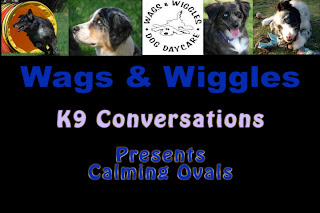Calming ovals is the better introduction to leash walking for the novice dog trainer. This technique was introduced to me by Kay Laurence. She's from England and doesn't come here often but when she does, you should run not walk to sign up. I have used the calming oval technique in our control unleashed classes for a few months now. It's a great warmup exercise to get the human end of the leash started with relaxing their dog.
My interpretation of calming ovals is for the dog to match the human's energy level that is holding the leash. No, this isn't some spiritual journey I want you to go on. If you walk slowly, and I mean slow, in the same pattern over and over, your dog will just match your energy level. At first they may bounce all over the place, trying to pull here or there. But then they just start to flow with you.
SIDE BAR: There is an assumption here that your dog has had enough leash training to not be fearful of the leash. Do not start this with young puppies, they should have lots of click/treats for wearing their leash loosely before you start this exercise.
You hold the leash firmly with two hands and clasp them to your waist. Your hands never move. You may have to shift your weight to stay upright but you keep your pattern going no matter what. If they try to cut in front of you, you use big marching band feet to keep them from cutting you off. If they lag behind, just keep walking the same pace and don't look back at them. Check out our tutorial video.
 |
| Click Picture to Play Video |

